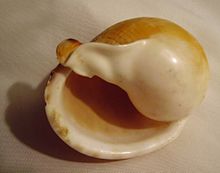This article needs additional citations for verification. (August 2011) |
A callus is an anatomical feature that exists in some mollusk shells, a thickened area of shell material that can partly or completely cover the umbilicus, or can be located as a coating on the body whorl near the aperture of the shell (i.e. a parietal callus or columellar callus). It is a hardened deposit of enamel, which varies in coloration and size depending on the species [1]

A funiculus (plural: funiculi) is a narrow ridge of callus spiraling from the upper lip into the umbilicus.
A callus exists in the shells of various species of gastropods (snails) and also in the shells of several species of Nautilus, a cephalopod.

A callum is an anatomical feature of some mature bivalve shells of species in the family Pholadidae, the piddocks.[2] The callum is an area of shell material that fills the gap between the two valves.[3]